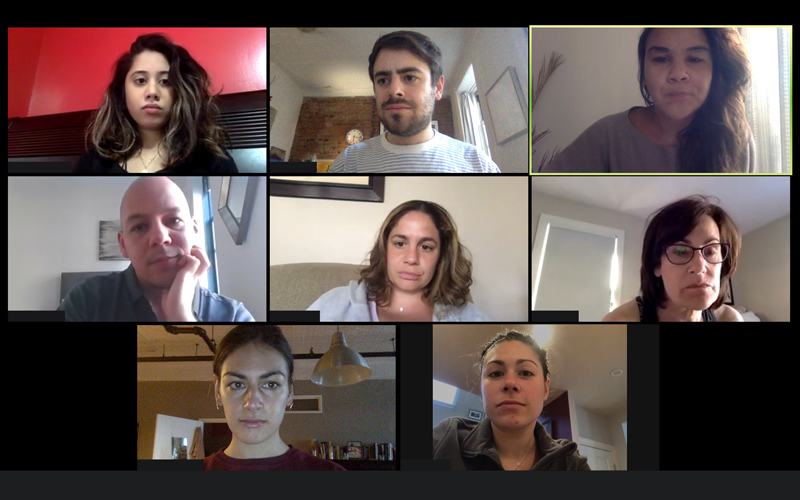Video content used to be a nice-to-have addition to typical digital marketing plans, but this is changing, and it’s changing quickly, especially if you want to reach a younger audience.
Take TikTok. Nearly 34% of its U.S.-based users aged 25–34 spent 58 minutes a day watching videos on the app. Streamed video content viewership numbers are growing across the board, making them hard to ignore. So if you’re starting to dip your toes into regular digital video marketing production and distribution, you might be wondering what you can do to ensure these assets deliver measurable results.
If you’re a CMO or marketing director looking to avoid common strategic pitfalls as you begin to do more video digital advertising, this post is for you. In this article, two experts in digital video marketing—Tatum Hindman (TBH Creative’s founder and president) and Andy Mork (Mork Productions’ CEO)—identify the biggest reasons advertising videos fail and share solutions for what to do instead.
Keep reading to find out how to plan great videos and learn what kind of marketing strategy you should put in place to support them (from timelines to budgets). Plus, discover how AI is playing a role in video production today.
9 mistakes to avoid with digital video marketing
Out of all of the many different reasons why some marketing videos fail, the following are the biggest things to steer clear of when creating video-based media assets to support advertising campaign work:
- Trying to measure video ROI like direct response campaigns
- Creating campaigns without a “why”
- Focusing only on production and ignoring distribution
- Inconsistent brand expression across video content
- Cramming too much information
- Not planning adequate marketing video creation timelines
- Misunderstanding video marketing production cost drivers
- Prioritizing high video production value over authenticity
- Waiting for perfect conditions
Trying to measure video ROI like direct response campaigns
Video, as a medium, works differently from other types of marketing like pay-per-click advertising and email, so you can’t measure results for this medium the same way you measure other kinds of direct response efforts.
Digital video marketing’s impact often occurs higher in the funnel (aka, where traditional attribution models break down). And, because it’s harder to make the connection between video views and revenue, sometimes businesses will give up and abandon video because they’ve concluded it doesn’t work. But, measuring video’s impact is doable. It just requires a different mindset since it doesn’t fit neatly into last-click attribution models.
What digital video marketing measurement should look like

Mork: Video can be a bit of an enigma because the temptation is often to think in hard numbers about direct ROI. When you can’t fully measure that, it becomes challenging to figure out where to spend your dollars.
Think about signage outside a company. Do you know how many people walked in specifically because they saw that sign? There are so many factors in marketing that are difficult to measure precisely.
If you look at large companies like Coca-Cola or McDonald’s, from an ROI standpoint, it’s probably hard to measure how many new cans of Coke were purchased because of a specific commercial. But it’s about connecting the brand with culture and associating their product with day-to-day life.

Hindman: Sometimes, video is the hardest to track in terms of exact ROI because it makes an impact in different ways.
We did a discovery session with a client a couple of years ago where we got to talk to doctors about what they liked best about their marketing over the last five to ten years. We had done paid ads, big campaigns, new websites, brand work, and many of them pulled out a commercial as what they remembered most. That was what stuck with them, even though it was more of an awareness piece rather than direct lead generation.
Pro-tip: Embrace broader impact metrics when measuring digital video marketing. Look for insights from sources, such as:
- Website traffic growth
- Brand awareness and sentiment surveys
- Social media engagement metrics, and
- Long-term customer journey analysis surveys
Track how video contributes to overall marketing goals rather than expecting immediate, directly attributable conversions.
Creating digital video marketing campaigns without a “why”
Another reason some marketers fall short when they jump into digital video production is that they skip a crucial step: identifying the business problem their video campaign assets are intended to solve. You might have heard this sort of thing before from a stakeholder (“XYZ Company has videos, so we need them too.”). You might benefit from digital video marketing, but its addition should be strategic because unfocused content, no matter the medium, more often than not will fail to drive meaningful business results.
Mork: No company truly wants or needs video itself. They need the result of it. What is that video going to do for their organization? Is it going to bring more people to their store? Get more clicks to their website, leading to consultation calls? Attract more talent for hiring? Get people to donate to their nonprofit? Video is just a tool to get there, like any other marketing tool. I typically recommend companies start with the “why” by asking, “What do you want to happen when you put this video out into the world?”
Hindman: Video is just one part of the customer journey. When people are watching videos, it’s often on their phones or laptops. And when they’re doing that, they’re not sitting there taking notes. They’re watching the video. They’re getting engaged or swiping to the next video.
Most of the time, they’re not going to rewatch a video to here tons of important details, even if they save the video to watch it again later. It reminds me of billboard design. If you’re just driving by a billboard, it has to grab your attention and get you to connect with what it’s trying to say. That’s a lot for the billboard to do if it’s trying to share lots of different information at once.

What does strategic thinking in videos look like in practice
This principle applies to a lot of things, but your why is especially critical in digital video marketing, where production costs and time investments demand clear thinking upfront. Before even a single frame is shot, make sure that your campaign strategy makes a connection between which of your target audience’s specific pain points your video will help solve.
Mork: Let’s say you’re a high-end kitchen remodeling company. In the best-case scenario, you want more people interested in remodeling their kitchens to book calls.
First, you’ll want to identify the target audience (medium- to high-income earners in older neighborhoods who want to start a kitchen remodeling project). Next, identify the group’s pain point and determine the best approach to help them envision their dream kitchen. But until you have figured out who your target audience is, what you provide can help them, and what you want them to do after watching the video, there’s no point in producing anything.
We’ve had people come to us saying, “I think we need a video for our company.” When I ask why, they say, “Well, our competition has videos.” When this happens, I refer them to marketing agencies first to develop their strategy.
Pro-tip: Define your “why” upfront. In his influential book Start With Why, Simon Sinek wrote, “People don’t buy what you do; they buy why you do it.” Use this principle to guide how you think about your “why” with digital video marketing (and figure out if this type of media is best to help you reach your goals).
To do this, start every project by answering three questions:
- What’s your video’s value proposition?
- Who exactly is the target audience?
- What action do you want viewers to take after watching?
By working backward from what is the best possible outcome instead of starting with your creative idea, you’ll have a stronger foundation to guide your marketing campaign video development and measurement.
Focusing only on production and ignoring distribution
Nurturing engagement shouldn’t be an afterthought. Even the most beautifully produced digital marketing video won’t get results if it’s not uploaded or if it’s posted but not shared. Videos with the highest ROI are developed with strategies that cover more than initial production. They have plans that include distribution planning and resource allocation for promotion and placement.
How digital video marketing distribution failures happen
Hindman: We’ve been in situations where clients have produced videos and haven’t rolled them out properly. They’ve invested significantly in video production, but—if that distribution piece has been missing—those fantastic videos go unseen.
Mork: That’s a huge pet peeve. Or maybe they posted it once—organically—and just got a few likes, and then wonder why they spent all that money. It’s because they didn’t fully utilize it.

If you’ve only shared a video once and shared it just one way—let’s say it’s an evergreen “who we are” video posted to your social media—you can’t expect your entire prospect base to have seen it. When someone sees the video, that’s their first time interacting with it, regardless of how many times you’ve posted it before. Some people might see it again and scroll past, and that’s okay. If anything, it’s another touchpoint.
Having an understanding of your broader marketing strategy helps video producers know your target and can make their creative decisions based on your desired outcomes. Usually, video is a supporting member of the cast of your marketing, and typically accompanies a larger campaign. This includes web, newsletters, social media posts, conference talks, etc. The more you have a handle on your broad go-to-market messaging, the better tools you’re giving your marketing agency and video producer partners.
Pro-tip: Plan distribution before production. Your digital video marketing syndication strategy should consider tactics like paid promotion, multiple organic posts, email marketing, website placement, and even sales team usage.
Don’t be afraid to embrace repetition. It’s not taboo to promote the same video multiple times across different channels and timeframes because most of your audience will only see the asset once or twice. Also, don’t forget to budget for distribution costs upfront to avoid surprises.
Inconsistent brand expression across video content
Digital video marketing brand consistency is nuanced, and it requires technical execution to serve your branding. You can’t just have someone say your slogan or add your company’s logo to the end frames and consider all things branding covered.
How branding misalignment happens in marketing videos
Mork: A video for McDonald’s is going to look very different from a high-end steakhouse. McDonald’s emphasizes fast, convenient, consistent quality. Their commercials are energetic, quick-moving, with smiles and a customer experience focus. A steakhouse is selling an experience you don’t want to rush (like reconnecting with your spouse or a chance to treat yourself). That’s why their videos are typically slower-moving, showing the steam off a medium-rare steak or the ambiance of the experience.
In terms of branding for digital marketing videos, look at existing marketing materials (website, marketing copy, colors, logo, and even physical locations) and consider positioning. Any videos that you create should be an extension of how you’re putting yourself out there in the market.
Pro-tip: Align style with brand promise. Your digital video marketing content’s pacing, visual style, and messaging should all be based on your established brand positioning to ensure consistency across all touchpoints.
Cramming in too much information
More isn’t more in digital marketing videos, where attention spans are measured in seconds. You must ruthlessly prioritize key messages to maximize video digital advertising success.
Just like with effective billboards and other outdoor advertising, you have very little time to reach your target audience with marketing campaign videos (and motivate them to take action). As you make video marketing content plans, keep in mind that you’ll have subsequent digital touchpoints (like websites and emails, etc.) where longer-form and more detailed information can be shared with prospects.

How information overload kills video performance
Mork: One common issue, especially with organizations new to video, is trying to put too much information into one video. Companies are passionate about what they do and want to tell people everything—company history, case studies, culture, pricing, locations, plans—all in a 60-second video. You have to look at the bigger picture of your marketing plan and realize this is just the first step.
Think again about McDonald’s and the golden arches signs outside each restaurant. This symbol communicates, “Hey, there’s a McDonald’s here,” but it doesn’t tell you this specific location’s menu, current specials, or prices. You have to go inside for that information.
Digital video marketing works similarly. You might see a cinematic view of a steakhouse in a YouTube ad and think, “I’d love to take my wife there,” and click through to its website. That’s when you’d see the hours, menu, and other details. Most of the time, marketing campaign videos are best for conveying feeling, emotion, and a broad call to action, not detailed information.
Pro-tip: Choose one key message per video. Identify the most critical message that will motivate your desired action, then build the entire video around that message. Prioritize the use of your company’s digital marketing videos to create interest and drive traffic, saving more comprehensive information sharing for distribution through other campaign assets.
Not planning adequate marketing video creation timelines
Most digital video marketing requires coordination to get it right. Rushed timelines for video advertising can force decision-making (around locations, talent, messaging, and visual concepts) and leave you short on time, resulting in an asset that doesn’t best support your campaign strategy.
Professional marketing video production works best when compression can be avoided because timelines include buffer time for weather delays, scheduling conflicts, technical glitches, or even somewhat inevitable creative iterations.
What realistic digital video marketing creation timelines look like
Mork: Let’s use a Christmas product launch example. If you want sales to go live by Black Friday, you’d want the video solidified by mid-November to allow time for ad buying and preparation. The marketing video creation timeline’s major steps might look like this:
- Pre-production (3 to 4 weeks): These strategic conversations involve figuring out the concept, brand identity, and logistics
- Production (1 day): The actual shoot day
- Post-production (2 to 3 weeks): First draft editing
- Revisions (3 weeks to 1 month): Client review and final decisions
For a Thanksgiving launch, I’d recommend starting conversations in late July or early August. That gives you three to four months of buffer time, allowing for schedule changes, weather issues, and thoughtful decision-making without pressure. Everything can be rush-jobbed, but having proper time ensures better results and less stress for everyone involved.
Pro-tip: Plan for major campaigns. Have a big launch coming up? Your digital video marketing planning should start about three to four months before you need the final content. For seasonal or time-sensitive campaigns, work backward from the go-live date to determine and add in buffers along the way. This strategic approach to your timeline planning can help prevent compromising video quality and the asset’s effectiveness in your campaign.
Misunderstanding video marketing production cost drivers
Not every marketing video needs Super Bowl production values to achieve its intended business impact. That said, production costs for advertising video content can vary dramatically, creating opportunity and risk for CMOs and marketing directors. To make budget decisions wisely, you must understand the factors that influence the final costs associated with digital video marketing.
What actually impacts pricing for marketing video production
Mork: Video pricing is extremely relative. I could record a 30-second video on my phone right now for essentially free. At the same time, a Super Bowl commercial of the same length might cost $1.7 million because of multiple locations, celebrities, 60 people on set, and 14 shoot days.
Major cost factors in digital video marketing productions include:
- Number of shoot days
- Location costs (soundstages, rental locations, Airbnbs)
- Talent (actors can each cost $2,000 to $3,000 per day through agencies)
- Crew size (makeup, catering for large shoots)
- Editing complexity (processing multiple interviews vs. scripted voiceover)

I’ve found that fully motion graphics videos and fully shot videos tend to be similar in price. With footage, you don’t need as much editing time, but you have to capture the footage. With motion graphics, you don’t need to capture footage, but every second has to be created and curated by an editor.
I prefer to start with the value this video will bring to your organization. From an ROI perspective, the video doesn’t need all the bells and whistles to accomplish its goal in the marketing campaign.
Pro-tip: Consider the potential value of your video when determining its budget. The specific business value this video should create can help you figure out the minimum production investment required. Keep in mind that shoot days, talent, and locations drive costs more than equipment quality, and remember that you should ideally base production approaches on strategic goals rather than aesthetic preferences.
Prioritizing high video production value
Authentic marketing outreach—video or otherwise—will have a greater likelihood of resonating with an audience when it feels real. Rather than creating idealized scenarios with hired actors, the most compelling digital video marketing builds trust by featuring actual customers, real employees, and genuine locations.
Why realness outperforms polish
Mork: I’m a huge fan of authenticity over expensive productions with hired actors. In healthcare, for example, interviewing a former patient who went through weight loss surgery and now has the mobility to play with their kids again. That impact story is gold. You can shoot that for much less than hiring actors and show how amazing your organization is while making that person feel special by sharing their story.
Authenticity in video content can be a powerful pattern interrupt among the massive ocean of content people consume. Your audience can sniff through the PR nonsense, but is attracted to real connections and honesty. So don’t say what you think you’re supposed to say. Say what’s authentic. Say what’s real. Say what’s true.
Pro-tip: Use real stories whenever you can. Authentic digital video marketing content builds trust and emotional connections that polished productions often cannot achieve, often at significantly lower production costs.
Waiting for perfect conditions
Waiting for a bigger budget, better equipment, or stronger concepts before getting started with digital video marketing? Perfectionism paralysis is real. But you don’t have to delay your projects that you want to include videos to support until you have that bigger budget, better equipment, or stronger creative concept.
The businesses that succeed with marketing video assets are those willing to jump in and start with simpler content. Going this route can help you build internal capabilities and gather/analyze audience feedback, allowing you to get a better sense of what works sooner.
Be like Nike: Just do it!
Mork: One thing I want to emphasize is how important it is to make content in the first place. The video of this conversation (embedded at the top of this post) can be cut into 20 different 60-second videos and used to drive traffic as social media shorts. This conversation has taken about an hour, but now it’s going to live online forever in video format, providing value to people who might not find it for three years.

People often feel intimidated about producing content, but your expertise is more valuable than you realize. Something as simple as recording a Zoom call where you talk about your expertise can bring in clients, especially in professional services.
Be okay with imperfections and pauses. People will listen to those if you’re providing valuable information.
Pro-tip: Start with the basics and iterate. Focus on providing value rather than achieving perfect production quality. Begin with straightforward, even imperfect, video content using available resources like videoconferencing calls, screen recordings, self-recorded smartphone videos, laptop webcams, etc.
What’s next in digital video marketing?
Thanks to artificial intelligence, new technologies, tools, and approaches are making it easier to create and distribute persuasive videos for marketing and do so with fewer resources. In the next section, our marketing video experts discuss AI and share examples of how different automation solutions are changing video marketing.
AI and trends in advertising videos
AI in marketing video excels when it’s called to enhance human creativity rather than replace it. For example, one of the best ways today that you can use AI solutions for advertising video production is to have these tools tackle technical tasks (like audio cleanup, color correction, and other repetitive editing work).
Doing these sorts of things with AI frees up creative professionals to focus on what bots can’t do because there aren’t datasets to pull from—that’s strategy and storytelling, two absolutely critical parts of any successful video production.
Mork: We’re in the infancy of AI being a major driver in video, specifically. I’m optimistic about new tools. I had a conversation with a veteran video producer who was struggling because “everyone has a cell phone camera now.” I realized he was tying his reputation to a specific era of technology rather than his skill as a creative storyteller.

Technology is always improving. The camera I’m using as a webcam right now is higher quality than cinema cameras from decades ago. Filmmakers shot the movie 28 Years Later entirely on iPhones.
AI is just another tool to bridge the gap between creative ideas and execution. It’s an exciting time for creators, especially those without access to Hollywood studios but who have brilliant creative ideas. Now they can use AI video software to bring those visions to life.
Examples of real-world AI applications in video advertising
Hindman: I have a colleague who had some videos professionally done for his company to go over processes and introduce himself. They were filmed in English, but he used AI to translate the videos to Spanish and other languages. Are the video variations perfect? No, but they’re pretty good considering he doesn’t speak a lick of Spanish.
Mork: At Mork Productions, we’re implementing AI as a tool in our editing process. We’ve used it to change a stool to a tree stump in a nature setting, add plants to boring interview backgrounds, and dramatically improve audio quality by isolating voices even in noisy environments.
Hindman: We had a client who recorded a voiceover with an actor, and they wanted to change a couple of words. Without re-hiring the actor, you guys were able to do that with AI.
Even in live footage, you can change a word if you’re willing to accept the screen fading out or clipping to something else. That was cool because just a couple of years ago, your team would have had to go back and redo it (or—if the budget wasn’t there—the client would have had to live with it the way it was initially recorded).
Mork: Yeah, that’s just one example of how the audio improvements in digital video marketing production have been amazing. We can now also film in busy coffee shops with conversations happening nearby and fully isolate the speaker’s voice as if they’re on a podcast mic.
Integrating digital video into your marketing strategy
Whether you’re just getting started with digital video marketing or looking to enhance the performance of existing video campaigns, TBH Creative can help you develop a strategic approach to advertising videos that maximizes ROI while avoiding the common mistakes that can sidetrack well-intentioned efforts.
Working with trusted partners like Mork Productions, we’ve helped clients avoid costly missteps while creating and distributing digital videos as part of strategic marketing campaigns. Let’s talk about how digital video planning can take your advertising campaigns up a notch.

